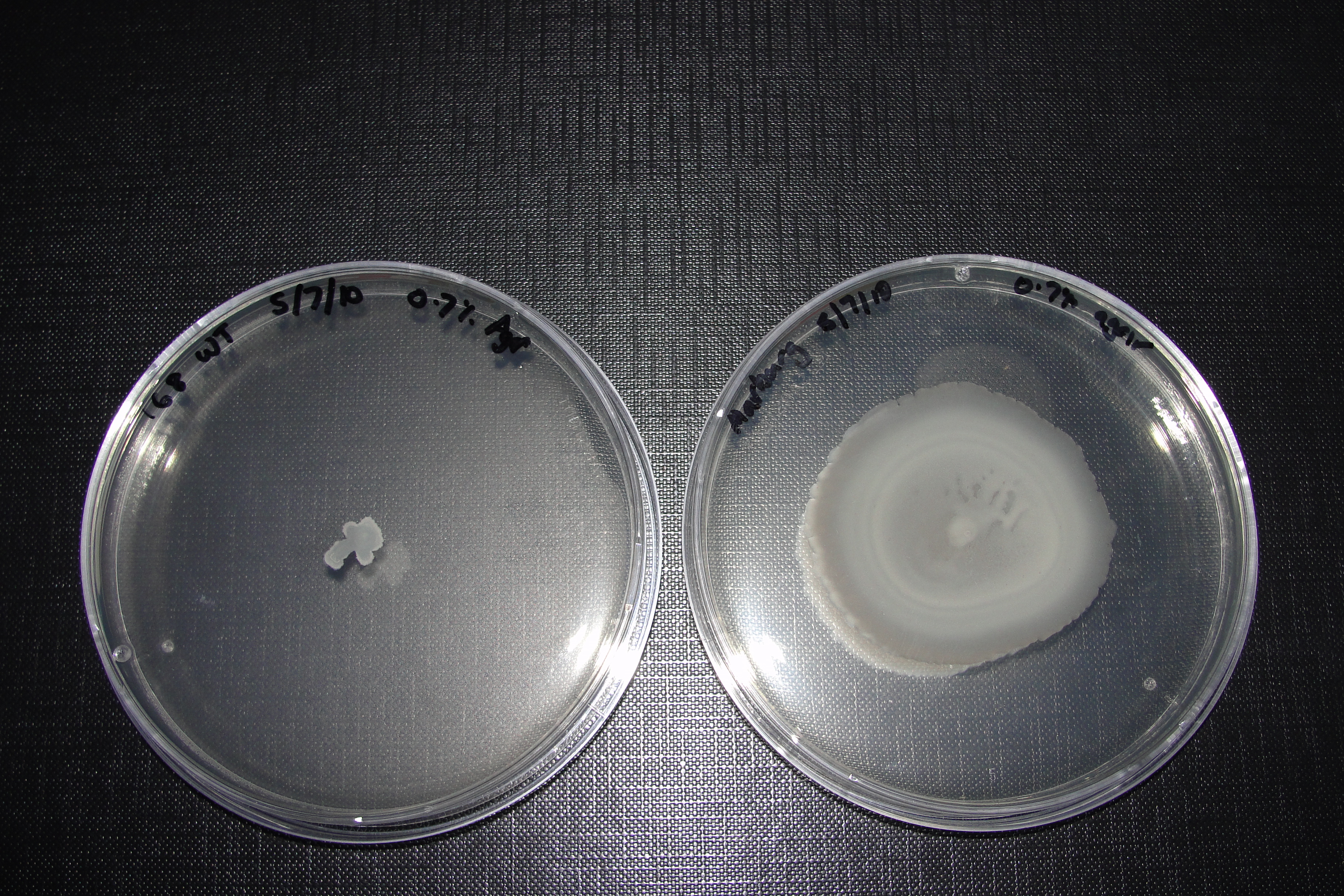Team:Newcastle/Swarming
From 2010.igem.org
(→swrA) |
(→efp) |
||
| Line 32: | Line 32: | ||
===''efp''=== | ===''efp''=== | ||
| - | ''efp'' stands for Elongation Factor P and this gene helps in the non dendritic swarming. | + | ''efp'' stands for "Elongation Factor P" and this gene helps in the non-dendritic swarming. |
===Pathway=== | ===Pathway=== | ||
Revision as of 10:28, 10 August 2010

| |||||||||||||
| |||||||||||||
Contents |
Swarming
It is known that Bacillus subtilis (strain 168) which is generally used in the lab is unable to swarm on a solid surface eg. agar plate. This is because of two reasons which are:
- Surfactin is a natural surfactant which helps in reducing surface tension and aids the bacteria to swarm on a solid or semi-solid medium. Strain 168 is unable to produce the bacterial cyclic lipopeptide surfactin.
- Strain 168 is also unable to biosynthesize flagellum and thus has a very low amount of swarming.
Genes required for swarming
- comP: Histidine sensor kinase of ComX and PhrC
- comA: Response regulator of Comp
- sfp: Active surfactin synthetase
- srfA,B and C: Surfactin synthetase
- swrA,B and C: Novel gene for swarming and not for swimming
- efp: elongation factor P
- yabR and ymfl: Contribute to proper coordinationamong cells of the swarming population but are not absolutely required for surface migration.
- cheC and D: chemotaxis protein
- sigD: transcription factor sigma D, which is required for the expression of genes activated in late phase of flagellum biosynthesis.
sfp
Strain 168 is unable to produce surfactin because it contains a frameshift mutation in the gene named sfp. In a non-domesticated strain 3610, sfp gene is intact and thus able to produce a protein which helps in the post-translational modification of the immature surfactin peptide formed by the srfABCD operon. After the modification, this peptide is exported out of the cell and helps in in the reduction of surface tension and aids the movement of the bacteria.
swrA
In the undomesticated strain 3610, the gene swrA along with the gene swrB helps in the biosynthesis of flagellum. swrA acts on the the gene sigD, which in turn acts as a transcription for the genes required in the late flagellum biosynthesis. The laboratory strain 168 contains a fameshift mutation in the gene swrA and thus the stain moves on the surface with a very slow pace.
swrC
It provides resistance to the antimicrobial action of the peptide surfactin.
efp
efp stands for "Elongation Factor P" and this gene helps in the non-dendritic swarming.
Pathway
Swarming of the colony cells starts when the concentration of the signalling peptide ComX and the pentapeptide pheromone CSF (encoded by phrC) reach a critical concentration and activates the sensor kinase ComP by phosphorylating it. ComP is a part of two component transduction system and thus activates response regulator ComA which is present downstream to ComP.
ComA targets srf operon which consists of four genes viz srf A,B,C, and D and it also targets ComS which is present upstream to the srf operon and it activates competence by displacing MecA from ComK and thus MecA is targeted for proteolysis by ClpC/ClpB. ComK regulates the genes required for competence.
While ComA is activating srf operon, another gene named sfp encodes 4' phosphopantetheinyl transferase which is required to activate each of the four surfactin synthases by the post translational modification of Srf A, Srf B, Srf C, and Srf D, which are required for the non ribosomal assembly of the surfactin heptapeptide.
Simultaneously, gene swrA activates the transcription factor sigD (sigma D) which acts on the genes required in the late flagellum biosynthesis.
Bibliography
- Julkowska, D, Obuchowski, M, Holland, IB & Se, SJ 2005, "Comparative Analysis of the Development of Swarming Communities of Bacillus subtilis 168 and a Natural Wild Type : Critical Effects of Surfactin and the Composition of the Medium." Society, vol. 187, no. 1, pp. 65-76.
- Kearns, DB & Losick, R 2004, "Swarming motility in undomesticated Bacillus subtilis." Molecular Microbiology, vol. 49, no. 3, pp. 581-590.
- Kearns, DB, Chu, F, Rudner, R & Losick, R 2004, "Genes governing swarming in Bacillus subtilis and evidence for a phase variation mechanism controlling surface motility." Molecular microbiology, vol. 52, no. 2, pp. 357-69.
 
|
 "
"
